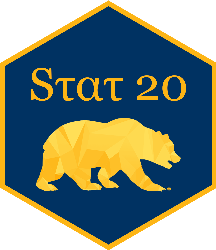Evaluating and Improving Predictions
STAT 20: Introduction to Probability and Statistics
Agenda
- Announcements
- Reading Questions
- Break
- Worksheet
Announcements
- Portfolio (four worksheets) due Friday at 5pm.
- Quiz 4 is next Thursday. Two sided, handwritten cheatsheet is allowed.
Reading Questions
- Please put your laptops under your desk and your phones away.
- Write your name, ID, and bubble in Version “A” on your answer sheet.
- You may work only with those at your table!
Compare \(r\) and \(R^2\), selecting all of the statements which are true.
A: \(r\) is a summary statistic between numerical variables that is often computed before a linear model is fit; \(R^2\) is fit to assess the performance of the linear model once it is fit.
B: Both \(r\) and \(R^2\) can take values between 0 and 1.
C: When fitting a linear regression model which involves multiple predictor variables, the goal is to fit a model which maximizes \(r\).
00:40
When adding a new variable to a linear regression model, what will happen to the \(R^2\) value as compared to what it was before?
- A: The \(R^2\) value will either be equal to what is was before, or less.
- B: We cannot determine this information.
- C: The \(R^2\) value will either be equal to what it was before, or greater.
00:30
When applying a transformation to a predictor variable before fitting a linear model (for example, squaring the predictor variable), the resulting function that describes the model is a _____ function of the transformed variable and a ____ function of the original variable.
- A: non-linear; non-linear
- B: linear; non-linear
- C: linear; linear
- D: non-linear; linear
00:40
You would like to generate predictions for new_x with a linear model that you built called m1. What data type/data structure does the argument supplied to newdata, new_x, need to be?
- A: vector
- B: logical
- C: integer
- D: data frame
- E: factor
00:30
Break
05:00
Worksheet: Evaluating and Improving Predictions
30:00
Appendix - More practice!
Concept Questions

Which two models will exhibit the highest \(R^2\)?
01:00
# A tibble: 4 × 5
name hours cuteness food_eaten is_indoor_cat
<chr> <dbl> <dbl> <dbl> <lgl>
1 castiel 12 9 175 TRUE
2 frank 18 10 200 TRUE
3 luna 19 9.5 215 FALSE
4 luca 10 8 218 FALSE (Intercept) cuteness food_eaten is_indoor_catTRUE
-3.800000e+01 6.000000e+00 2.815002e-16 -4.000000e+00 How many hours does the model predict Frank will sleep each day? Write out the linear equation of the model from the model output to help you.
03:00
Which is the most appropriate non-linear transformation to apply to time_being_pet?

01:00
Worksheet
25:00
Lab
45:00
